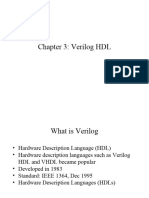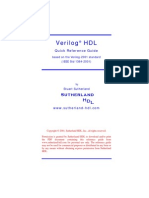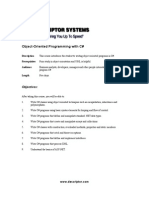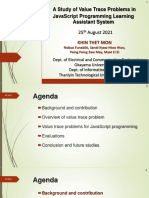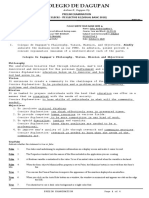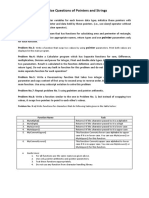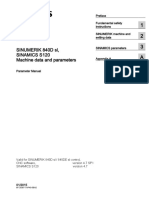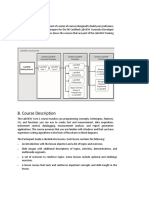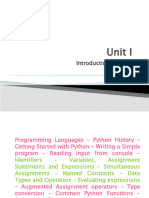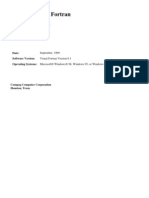Verilog HDL Quick Reference Guide
Author: Nikola Jevtovi Computer Science Department School of Electrical Engineering University of Belgrade email: jevtovic.nikola@gmail.com
�Reference
On-line Verilog HDL Quick Reference Guide
by Stuart Sutherland of Sutherland HDL, Inc. - Portland, Oregon, USA
http://www.sutherland-hdl.com/
jevtovic.nikola@gmail.com Verilog HDL Quick Reference Guide 2
�Verilog HDL Quick Reference Guide
1. Hierarchy Scopes 2. Concurrency 3. Reserved Keywords 4. Lexical Conventions 5. Module Definitions 6. Module Port Declarations 7. Data Type Declarations 8. Module Instances 9. Primitive Instances 10. Procedural Blocks 11. Operators 12. Continuous Assignments 13. Task Definitions 14. Function Definitions 15. Specify Blocks 16. User Defined Primitives
jevtovic.nikola@gmail.com
Verilog HDL Quick Reference Guide
�1. Hierarchy Scopes
Verilog HDL constructs that represent hierarchy scope are:
Module definitions Function definitions Task definitions Named statement blocks ( begin - end or fork - join) Specify blocks
Each scope has its own name space. An identifier name defined within a scope is unique to that scope. References to an identifier name will search first in the local scope, and then search upward through the scope hierarchy up to a module boundary.
jevtovic.nikola@gmail.com Verilog HDL Quick Reference Guide 4
�2. Concurrency
The following Verilog HDL constructs are independent processes that are evaluated concurrently in simulation time:
Module instances Primitive instances Continuous assignments Procedural blocks
jevtovic.nikola@gmail.com
Verilog HDL Quick Reference Guide
�3. Reserved Keywords
always and assign attribute begin buf bufif0 bufif1 case casex casez cmos deassign default defparam disable edge else end endattribute endcase endfunction endmodule endprimitive endspecify endtable endtask event for force forever fork function highz0 highz1 if ifnone initial inout input integer join medium module large macromodule nand negedge nmos nor not notif0 notif1 or output parameter pmos posedge primitive pull0 pull1 pulldown pullup rcmos real realtime reg release repeat rnmos rpmos rtran rtranif0 rtranif1 scalared signed small specify specparam strength strong0 strong1 supply0 supply1 table task time tran tranif0 tranif1 tri tri0 tri1 triand trior trireg unsigned vectored wait wand weak0 weak1 while wire wor xnor xor
jevtovic.nikola@gmail.com
Verilog HDL Quick Reference Guide
�4. Lexical Conventions
4.1 White Space Characters
blanks, tabs, newlines (carriage return), formfeeds and EOF (end-of-file).
4.2 Comments
// begins a single line comment, terminated by a newline. /* begins a multi-line comment, terminated by a */.
4.3 Case Sensitivity
Verilog is case sensitive!
Verilog HDL Quick Reference Guide 7
jevtovic.nikola@gmail.com
�4. Lexical Conventions
4.4 Identifiers (names)
Must begin with alphabetic or underscore characters a z A Z _ May contain the characters a z A Z 0 9 _ and $ May use any character by escaping with a backslash ( \ ) at the beginning of the identifier, and terminating with a white space.
Examples Notes
adder XOR \reset*
jevtovic.nikola@gmail.com
legal identifier name uppercase identifier is unique from xor keyword an escaped identifier (must be followed by a white space)
Verilog HDL Quick Reference Guide 8
�4. Lexical Conventions
4.5 Logic Values
The Verilog HDL has 4 logic values:
Logic Value Description 0 zero, low, or false 1 one, high, or true z or Z high impedance (tri-stated or floating) x or X unknown or uninitialized
jevtovic.nikola@gmail.com
Verilog HDL Quick Reference Guide
�4. Lexical Conventions
4.6 Logic Strengths
The Verilog HDL has 8 logic strengths: 4 driving, 3 capacitive, and high impedance (no strength).
Strength Level 7 6 5 4 3 2 1 0
Strength Name
Specification Keyword
Display Mnemonic
Su0 St0 Pu0 Su1 St1 Pu1
supply0 supply1 Supply Drive strong0 strong1 Strong Drive pull0 pull1 Pull Drive large Large Capacitive weak0 weak1 Weak Drive medium Med. Capacitive small Small Capacitive High Impedance highz0 highz1
Verilog HDL Quick Reference Guide
La0
We0 Me0 Sm0 HiZ0
La1
We1 Me1 Sm1 HiZ1
10
jevtovic.nikola@gmail.com
�4. Lexical Conventions
4.7 Literal Integer Numbers
Syntax: size'base value Sized integer in a specific radix (base) size (optional) is the number of bits in the number. Unsized integers default to at least 32-bits. 'base (optional) represents the radix. The default base is decimal.
Base binary octal Symbol b or B o or O Legal Values 0, 1, x, X, z, Z, ?, _ 0-7, x, X, z, Z, ?, _
decimal
hexadecimal
jevtovic.nikola@gmail.com
d or D
h or H
0-9, _
0-9, a-f, A-F, x, X, z, Z, ?, _
Verilog HDL Quick Reference Guide 11
�4. Lexical Conventions
4.7 Literal Integer Numbers
The ? is another way of representing the Z logic value. An _ (underscore) is ignored (used to enhance readability). Values are expanded from right to left (lsb to msb). When size is less than value, the upper bits are truncated. When size is larger than value, and the left-most bit of value is 0 or 1, zeros are left-extended to fill the size. When size is larger than value, and the left-most bit of value is Z or X, the Z or X is left-extended to fill the size.
Examples Notes 10 unsized decimal 0...01010 (32-bits) 'o7 unsized octal 0...00111 (32-bits) 1'b1 1 bit binary 1 8'Hc5 8 bits hex 11000101 6'hF0 6 bits hex 110000 (truncated) Verilog HDL Quick Reference Guide 6'hF 6 bits hex 001111 (zero filled) 6'hZ 6 bits hex ZZZZZZ (Z filled)
jevtovic.nikola@gmail.com
12
�4. Lexical Conventions
4.8 Literal Real Numbers
Syntax: value.value decimal notation baseEexponent scientific notation (the E is not case sensitive) Real numbers are limited to the values 0-9 and underscore. There must be a value on either side of the decimal point.
Examples Notes 0.5 must have value on both sides of decimal point 3e4 3 times 104 (30000) 5.8 times 10-3 (0.0058) 5.8E-3
jevtovic.nikola@gmail.com
Verilog HDL Quick Reference Guide
13
�5. Module Definitions
Verilog HDL models are represented as modules. Syntax: Implicit Internal Connection (connects the port to an internal net or register of the same name )
module module_name (port_name, port_name, ... ); {module_items} endmodule
-
Explicit Internal Connection (connects the port to an internal signal with a different name, or a bit select, part select, or concatenation of internal signals)
module module_name (.port_name (signal_name ), .port_name (signal_name ), ... ); {module_items} endmodule
jevtovic.nikola@gmail.com Verilog HDL Quick Reference Guide 14
�5. Module Definitions
module_items are:
module port declarations data type declarations module instances primitive instances procedural blocks continuous assignments task definitions function definitions specify blocks
Module functionality may be: - Behavioral - modeled with procedural blocks or continuous assignment statements. - Structural - modeled as a netlist of module instances or primitive instances. - A combination of behavioral and structural.
jevtovic.nikola@gmail.com
Verilog HDL Quick Reference Guide
15
�5. Module Definitions
Module definitions may not be nested. Instead, modules instantiate other modules. Module definitions may be expressed using parameter constants. Each instance of a module may redefine the parameters to be unique to that instance. Module items may appear in any order, but port declarations and data type declarations should be listed before the ports or signals are referenced.
jevtovic.nikola@gmail.com
Verilog HDL Quick Reference Guide
16
�6. Module Port Declarations
Syntax:
port_direction [port_size] port_name, port_name,... ; port_direction is declared as: - input for scalar or vector input ports. - output for scalar or vector output ports. - inout for scalar or vector bi-directional ports. port_size is a range from [ msb : lsb ]
Examples
input a,b,sel; output [7:0] result; inout [0:15] data_bus; input [15:12] addr; parameter word = 32; input [word-1:0] addr;
jevtovic.nikola@gmail.com
Notes 3 scalar ports little endian convention big endian convention msb:lsb may be any integer constant expressions may be used
17
Verilog HDL Quick Reference Guide
�7. Data Type Declarations
Syntax:
register_type [size] variable_name , variable_name,...; register_type [size] memory_name [array_size]; net_type [size] #(delay) net_name , net_name , ... ; net_type (drive_strength) [size] #(delay) net_name = continuous_assignment ; trireg (capacitance_strength) [size] #(delay, decay_time) net_name, net_name,...; parameter constant_name = value,constant_name = value,...; specparam constant_name = value,constant_name = value,...; event event_name, event_name, ... ; delay (optional) may only be specified on net data types. size is a range from [msb : lsb]. array_size is from [ first_address : last_address] strength (opt.) specified as (strength1,strength0) or _(strength0,strength1) decay_time (opt.) The syntax is (rise_delay,fall_delay,decay_time)
jevtovic.nikola@gmail.com Verilog HDL Quick Reference Guide 18
�7. Data Type Declarations
7.1 Register Data Types
Functionality reg unsigned variable of any bit size integer signed 32-bit variable time unsigned 64-bit variable real or realtime double-precision floating point variable Register data types are used as variables in procedural blocks. Registers store logic values only (no logic strength). A register data type must be used when the signal is on the left-hand side of a procedural assignment. Keyword
jevtovic.nikola@gmail.com
Verilog HDL Quick Reference Guide
19
�7. Data Type Declarations
7.2 Net Data Types
Keyword
Functionality wire or tri Simple interconnecting wire wor or trior Wired outputs OR together wand or triand Wired outputs AND together tri0 Pulls down when tri-stated tri1 Pulls up when tri-stated supply0 Constant logic 0 (supply strength) supply1 Constant logic 1 (supply strength) trireg Stores last value when tri-stated (capacitance strength)
Nets transfer both logic values and logic strengths. A net data type must be used when a signal is driven by the output of some device; a signal is also declared as an input port or inout port; a signal is on the left-hand side of a continuous assignment.
jevtovic.nikola@gmail.com Verilog HDL Quick Reference Guide 20
�7. Data Type Declarations
7.3 Other Data Types
Functionality Run-time constant for storing integers, real numbers, time, delays, or ASCII strings. Parameters may be redefined for each instance of a module. Specify block constant for storing integers, real numbers, time, delays or ASCII strings A momentary flag with no logic value or data storage. Often used for synchronizing concurrent activities within a module.
Other Types
parameter specparam event
jevtovic.nikola@gmail.com
Verilog HDL Quick Reference Guide
21
�7. Data Type Declarations
7.4 Data Type Declaration Examples
Data Type Examples Notes
wire a, b, c;
3 scalar nets tri1 [7:0] data_bus; 8-bit net, pulls-up when tri-stated reg [1:8] result; an 8-bit unsigned variable a memory array; 8-bits wide, reg [7:0] RAM [0:1023]; with 1K of addresses wire #(2.4,1.8) carry; a net with rise, fall delays net with drive strength and a wire (strong1,pull0) sum = a+b; continuous assignment trireg (small) #(0,0,35) ram_bit; net with small capacitance and 35 time unit decay time
jevtovic.nikola@gmail.com
Verilog HDL Quick Reference Guide
22
�8. Module Instances
Syntax: Port Order Connections
module_name instance_name [instance_array_range] (signal, signal, ... );
-
Port Name Connections Explicit Parameter Redefinition Implicit Parameter Redefinition
module_name instance_name [instance_array_range] (.port_name(signal), (.port_name(signal), ...);
-
defparam heirarchy_path.parameter_name = value;
module_name #(value) instance_name (signals);
instance_name (required) is used to make multiple instances of the
same module unique from one another. instance_array_range (optional) instantiates multiple modules, each instance connected to separate bits of a vector.
jevtovic.nikola@gmail.com Verilog HDL Quick Reference Guide 23
�8. Module Instances
Module Instance Examples
module reg4 (q,d,clock); module dff (q,qb,data,clk); output [3:0] q; output q, qb; input [3:0] d; input data, clk; input clock; //default delay parameter wire [3:0] q, d; parameter delay = 1; wire clock; dff_udp #(delay) (q,data,clk); //port order connection, not (qb, q); //2nd port not connected endmodule dff u1 (q[0], , d[0], clock); //port name connection, //qb not connected dff u2 (.clk(clock),.q(q[1]),.data(d[1])); //explicit parameter redefine dff u3 (q[2], ,d[2], clock); defparam u3.delay = 3.2; //implicit parameter redefine dff #(2) u4 (q[3], , d[3], clock); endmodule
jevtovic.nikola@gmail.com Verilog HDL Quick Reference Guide 24
�8. Module Instances
Array of Instances Examples
module tribuf8bit(out,in,enable); output [7:0] y; input [7:0] a; input en; wire [7:0] y, a; wire en; //array of 8 Verilog tri-state //primitives each bit of the //vectors is connected to a //different primitive instance bufif1 u[7:0] (y,a,en); endmodule
module tribuf64bit (out,in,enable); output [63:0] out; input [63:0] in; input enable; wire [63:0] out, in; wire enable; //array of 8 8-bit tri-state //buffers;each instance is connected //to 8-bit part selects of the 64-bit //vectors;The scalar enable line is //connected to all instances tribuf8bit i[7:0] (out,in,enable); endmodule
jevtovic.nikola@gmail.com
Verilog HDL Quick Reference Guide
25
�9. Primitive Instances
Syntax Gate Type
gate_type (drive_strength) #(delay) instance_name [instance_array_range] (terminal, terminal, ... ); Gate Type
and or xor buf bufif0 bufif1 pullup nand nor xnor not notif0 notif1 pulldown
Terminal Order (1_output, 1-or-more_inputs) (1-or-more_outputs, 1_input) (1_output, 1_input, 1_control) (1_output) (1_output, 1-or-more_inputs)
user-defined-primitives
jevtovic.nikola@gmail.com
Verilog HDL Quick Reference Guide
26
�9. Primitive Instances
Syntax Switch Type
switch_type #(delay) instance_name [instance_array_range] (terminal, terminal, ... ); Switch Type
pmos nmos cmos tran tranif0 rtranif0 rpmos rnmos rcmos rtran rtranif1 rtranif1
Terminal Order (1_output, 1_input, 1_control)
(1_output, 1_input, n_control, p_control) (2_bidirectional-inouts)
(2_bidirectional-inouts, 1_control)
jevtovic.nikola@gmail.com
Verilog HDL Quick Reference Guide
27
�9. Primitive Instances
Primitive Delay Syntax #delay or #(delay) Single delay for all output transitions
#(delay, delay)
Separate delays for (rising, falling) transitions
#(delay, delay, delay)
Separate delays for (rising, falling, turn-off) transitions
#(min_delay:typ_delay:max_delay) #(min_delay:typ_delay:max_delay, min_delay:typ_delay:max_delay)
Minimum to maximum range of delays for all transitions
Min. to max. range of delays for (rising, falling) transitions
#(min_delay:typ_delay:max_delay, min_delay:typ_delay:max_delay, min_delay:typ_delay:max_delay)
jevtovic.nikola@gmail.com
Min. to max. range of delays for (rising, falling, turn-off) transitions
Verilog HDL Quick Reference Guide 28
�9. Primitive Instances
Primitive Instance Examples and i1 (out,in1,in2); and #5 (o,i1,i2,i3,i4); not #(2,3) u7(out,in); buf (pull0,strong1)(y,a); wire [31:0] y, a; buf #2.7 i[31:0] (y,a); Notes zero delay gate primitive same delay for all transitions separate rise & fall delays output drive strengths model ECL
array of 32 buffers
jevtovic.nikola@gmail.com
Verilog HDL Quick Reference Guide
29
�10. Procedural Blocks
type_of_block @(sensitivity_list) statement_group: group_name local_variable_declarations timing_control procedural_statements end_of_statement_group type_of_block is either initial or always: - initial procedural blocks process statements one time. - always procedural blocks process statements repeatedly. statement_group--end_of_statement_group is used to group two or
Syntax:
more procedural statements together and control the execution order: - begin--end groups two or more statements together sequentially. - fork--join groups two or more statements together in parallel.
jevtovic.nikola@gmail.com
Verilog HDL Quick Reference Guide
30
�10. Procedural Blocks
Procedural Block Examples
initial fork bus = 16'h0000; #10 bus = 16'hC5A5; #20 bus = 16'hFFAA; join always @(a or b or ci) begin sum = a + b + ci; end always @(posedge clk) q <= data;
Notes
initial procedure executes statements one time; The fork--join group places statements in parallel.
always procedure executes
statements repeatedly. a statement group is not required when there is only one statement
jevtovic.nikola@gmail.com
Verilog HDL Quick Reference Guide
31
�10. Procedural Blocks
10.1 Timing Controls
#delay delays execution for a specific amount of time. The delay
may be a literal number, a variable, or an expression. @(edge signal or edge signal or ... ) Delays execution until there is a logic transition on a signal: edge (optional) maybe either posedge or negedge. If no edge is specified, then any logic transition is used. or is used to specify events on any of several signals. signal may be scalar or vector, and any data type. wait (expression) Delays execution until the expression evaluates as true.
jevtovic.nikola@gmail.com
Verilog HDL Quick Reference Guide
32
�10. Procedural Blocks
10.2 Procedural Assignments
Blocking : Non-blocking : Delayed :
register_data_type = expression;
-
register_data_type <= expression;
-
timing_control register_data_type = expression; timing_control register_data_type <= expression;
-
Blocking intra-delayed : Non-blocking intra-delayed :
register_data_type = timing_control expression;
-
register_data_type <= timing_control expression;
jevtovic.nikola@gmail.com Verilog HDL Quick Reference Guide 33
�10. Procedural Blocks
10.2 Procedural Assignments
Procedural continuous assignment : De-activating a procedural continuous assignment : Forcing any data type to a value : Removing the effect of a force :
assign register_data_type = expression;
-
deassign register_data_type;
-
force net_or_register_data_type = expression;
-
release net_or_register_data_type;
jevtovic.nikola@gmail.com
Verilog HDL Quick Reference Guide
34
�10. Procedural Blocks
10.3 Programming Statements
If statement :
if (expression) statement or statement_group
Case
if (expression) statement or statement_group else statement or statement_group
If-else statement :
case (net_or_register_or_literal) case_match1: statement or statement_group case_match2, case_match3: statement or statement_group default: statement or statement_group endcase casez (net_or_register_or_literal) casex (net_or_register_or_literal)
jevtovic.nikola@gmail.com
statements:
//a Z is logic value that represents don't-care bits.
//Z or X are logic values that represent don't-care bits.
Verilog HDL Quick Reference Guide 35
�10. Procedural Blocks
10.3 Programming Statements
Loops:
forever statement or statement_group
repeat (number) statement or statement_group while (expression) statement or statement_group for (initial_assignment; expression; step_assignment) statement or statement_group
Discontinuing execution :
disable group_name;
jevtovic.nikola@gmail.com
Verilog HDL Quick Reference Guide
36
�10. Procedural Blocks
Procedural Statement Examples
//A 50 ns clock oscillator that starts after 1000 time units initial begin clk = 0; #1000 forever #25 clk = ~clk; end //Sensitivity list models sequential logic always @(posedge clk) begin //Non-blocking assignments avoid race conditions in the byte swap word[15:8]<= word[7:0]; word[7:0] <= word[15:8]; end //Sensitivity list models combinational logic always @(a or b or sel) if (sel==0) y = a + b; else y = a * b;
jevtovic.nikola@gmail.com Verilog HDL Quick Reference Guide 37
�11. Operators
Arithmetic Operators
m+n
m-n
m*n
m/n
m%n
Bitwise Operators
~m
&m
m&n
m|n
m^n
^m
m~^n
~^m
m^~n
^~m
Unary Reduction Operators
~&m|m !m
~|m m&&n
Logical Operators
m||n
Equality Operators (compares logic values of 0 and 1)
m==n m!=n
Identity Operators (compares logic values of 0, 1, X and Z)
m===n m!==n
Relational Operators
m<n m>n
m<=n
m>=n
Logical Shift Operators Miscellaneous Operators
sel?m:n
m<<n
{m,n}
m>>n
{n{m}} ->m
38
jevtovic.nikola@gmail.com
Verilog HDL Quick Reference Guide
�11. Operators
! * + << < == & ^ | && || ?: ~ / >> <= != ~& ~^ ~| + % (unary) (binary)
highest
precedence
> ===
>= !==
lowest
Verilog HDL Quick Reference Guide 39
jevtovic.nikola@gmail.com
�12. Continuous Assignments
-
Syntax Explicit Continuous Assignment
net_type [size] net_name; assign #(delay) net_name = expression;
Implicit Continuous Assignment
net_type (strength) [size] net_name = expression;
Continuous Assignment Examples //A 32-bit wide 2:1 MUX wire [31:0] mux_out; assign mux_out = sel? a : b; //A 16-bit wide tri-state buffer with delay tri [0:15] #2.8 buf_out = en? in: 16'bz; //A 64-bit ALU with ECL output strengths wire [63:0] (strong1,pull0) alu_out= alu_function(opcode,a,b);
jevtovic.nikola@gmail.com Verilog HDL Quick Reference Guide 40
�13. Task Definitions
Syntax
task task_name; input, output, and inout declarations local variable declarations procedural_statement or statement_group endtask Example of a Task task read_mem; //TASK DEFINITION input [15:0] address; //declaration order output [31:0] data; // determines order begin // of arguments when read_request = 1; // task is called wait (read_grant) addr_bus = address; data = data_bus; #5 addr_bus = 16'bz; read_request = 0; end endtask read_mem(PC, IR); //TASK CALL
jevtovic.nikola@gmail.com Verilog HDL Quick Reference Guide 41
�14. Function Definitions
Syntax
function [size_or_type] function_name; input declarations local variable declarations procedural_statement or statement_group endfunction Example of a Function
function [7:0] GetByte; //FUNCTION DEFINITION input [63:0] Word; //declaration order input [3:0] ByteNum; //determines order integer Bit; //of arguments when reg [7:0] temp; //called begin for (Bit=0; Bit<=7; Bit=Bit+1) temp[Bit] = Word[((ByteNum-1)*8)+Bit]; GetByte = temp; //A function returns end // the value assigned endfunction // to its name this_byte = GetByte(data,4); //FUNCTION CALL
jevtovic.nikola@gmail.com Verilog HDL Quick Reference Guide 42
�15. Specify Blocks
Syntax
specify specparam_declarations timing_constraint_checks simple_pin-to-pin_path_delay edge-sensitive_pin-to-pin_path_delay state-dependent_pin-to-pin_path_delay endspecify
15.1 Specparam Declarations
specparams are constants used to store delays, delay calculation
specparam param_name = value, param_name = value, ...;
factors, synthesis factors, etc. value may be integer, real, delay, or quoted string.
jevtovic.nikola@gmail.com
Verilog HDL Quick Reference Guide
43
�15. Specify Blocks
15.2 Timing Constraint Checks
$setup(data_event,reference_event,setup_limit,notifier); $hold(reference_event,data_event,hold_limit, notifier); $setuphold(reference_event,data_event,setup_limit,hold_limit, notifier); $skew(reference_event,data_event,skew_limit,notifier); $recovery(reference_event,data_event,limit,notifier); $period(reference_event,period_limit,notifier); $width(reference_event,width_limit,width_threshold,notifier);
The reference_event is an edge of an input signal that establishes a reference point for changes on the data event. The data_event is the input signal that is monitored for changes. The limit and threshold are delay values. The notifier (optional) is a reg variable used as a flag.
Verilog HDL Quick Reference Guide 44
jevtovic.nikola@gmail.com
�15. Specify Blocks
15.3 Pin-to-pin Path Delays
Simple path delay statement:
(input_port polarity:path_token output_port) = (delay);
Edge-sensitive path delay:
(edge input_port path_token (output_port polarity:source)) = (delay);
State-dependent path delay:
if (first_condition) simple_or_edge-sensitive_path_delay if (next_condition) simple_or_edge-sensitive_path_delay ifnone simple_path_delay
path_token is either *> for full or => for parallel connection. edge (optional) may be either posedge or negedge. source (optional) is the input port or value the output will receive.
jevtovic.nikola@gmail.com
Verilog HDL Quick Reference Guide
45
�15. Specify Blocks
Specify Block Examples
(a => b) = 1.8; //parallel connection path; one delay for all output transitions (a -*> b) = 2:3:4;/*full connection path; one min:typ:max delay range for all output transitions; b receives the inverted value of a */ specparam t1 = 3:4:6, //different path delays for rise, fall transitions t2 = 2:3:4; (a => y) = (t1,t2); (a *> y1,y2) = (2,3,4,3,4,3);//different delays for 6 output transitions (posedge clk => (qb -: d)) = (2.6, 1.8); /* edge-sensitive path delay; timing path is positive edge of clock to qb; qb receives the inverted value of data*/ if (rst && pst) (posedge clk=> (q +: d))=2; //state-dependent edge sensitive path delay if (opcode = 3'b000) // state-dependent path delays; (a,b *> o) = 15; // an ALU with different delays for certain if (opcode = 3'b001) // operations; (a,b *> o) = 25; ifnone (a,b *> o) = 10; // (default delay has no condition) jevtovic.nikola@gmail.com Verilog HDL Quick Reference Guide 46
�16. User Defined Primitives (UDPs)
Syntax
primitive primitive_name (output, input, input, ... ); output terminal_declaration; input terminal_declaration; reg output_terminal; initial output_terminal = logic_value; table table_entry; table_entry; endtable endprimitive
input_logic_values : output_logic_value ; input_logic_values : previous_state : output_logic_value ;
jevtovic.nikola@gmail.com Verilog HDL Quick Reference Guide 47
Combinational logic table entry: Sequential logic table entry:
�16. User Defined Primitives (UDPs)
UDP Examples primitive mux (y, a, b, sel); //COMBINATIONAL UDP output y; input sel, a, b; table //table order for inputs matches primitive statement // a b sel : y 0 ? 0 : 0; //select a; don't care about b 1 ? 0 : 1; //select a; don't care about b ? 0 1 : 0; //select b; don't care about a ? 1 1 : 1; //select b; don't care about a endtable endprimitive
jevtovic.nikola@gmail.com
Verilog HDL Quick Reference Guide
48
�16. User Defined Primitives (UDPs)
UDP Examples primitive dff (q,d,clk,rst); //SEQUENTIAL UDP output q; input clk, rst, d; reg q; //declaring output as reg defines //sequential device with an internal //storage state initial q = 0; //powers up in reset state table // d clk rst:state:q ? ? 0 : ? :0; //low true reset 0 R 1 : ? :0; //clock in a 0 1 R 1 : ? :1: //clock in a 1 ? N 1 : ? :-; //ignore negedge of clk * ? 1 : ? :-; //ignore all edges on d ? ? P : ? :-; //ignore posedge of rst 0 (0X) 1 : 0 :-; //reduce pessimism 1 (0X) 1 : 1 :-; //reduce pessimism endtable endprimitive
jevtovic.nikola@gmail.com Verilog HDL Quick Reference Guide 49






